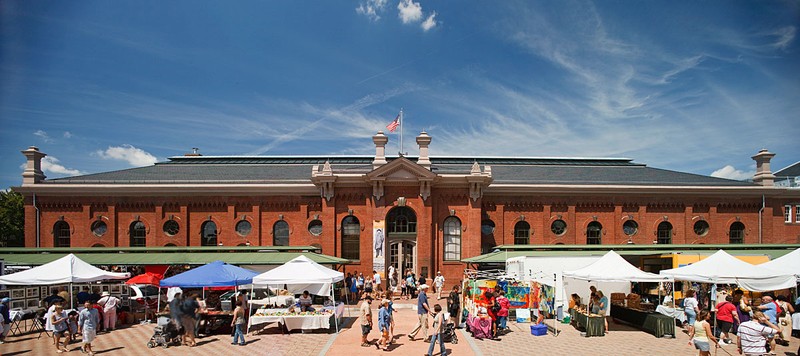Eastern Market
Introduction
Text-to-speech Audio
Images
Eastern Market (2010) by AgnosticPreachersKid on Wikimedia Commons (CC BY-SA 3.0)

Backstory and Context
Text-to-speech Audio
It was developed as part of a city-wide public market to help attract people to the city. It was built as part of a public works program following the Civil War. Architect Adolf Cluss, a German immigrant who also designed the Smithsonian Arts and Industries Building on the Mall, designed the market. The original building was a one-story structure of brick masonry, running along 7th Street.
The market grew out of the Eastern Branch Market, which operated from 1806 on 7th Street near K and L Streets. In 1872, the city government approved the purchase of land at the current site and to build the new public market. The market opened in 1873. Originally, the market had 85 stalls for vendors to sell food and other goods, including pastries, seafood, meat and poultry, herbs, flowers, and vegetables.
As Washington DC grew in the 20th century the need to expand the market became paramount. Architect Snowden Ashford designed a new addition featuring the Center and North Halls. The addition was completed in 1908.
Through the years customer interest waned and competition from grocery store chains took its toll. The city was prepared to close the Market in 1929 but enough support in protest saved it. It struggled following World War II and eventually was taken over by private management. By 1960, only two tenants remained in the market: Maryland Seafood Company and Union Meat Company; this changed three years later when 15 merchants relocated to Eastern Market after being forced to leave Center City Fish Market.
More recently it has been a vibrant part of urban revitalization. In 2007, the building suffered significant damage from fire. Individuals and groups throughout the city agreed that it needed to rebuild not only the structure of the market, but the community it had sustained. As a result a public-private partnership including District government under mayor Adrian Fenty, the Eastern Market Community Advisory Committee, and the Capitol Hill Community Foundation raised funds to restore the building. Merchants used temporary spaces for their stalls until the market reopened in 2009. Today Eastern Market features a wide variety of vendors. Merchants offer farm-fresh produce and meats, delis, groceries, flowers, pottery, antiques and a wealth of handmade arts and crafts. The Market offers regular special activities while its popular North Hall also serves as a unique venue for weddings, receptions, fundraisers and other community events.
Sources
Eastern Market DC. Our History, Eastern Market. 2020. Accessed October 10th 2020. http://easternmarket-dc.org/our-history/.
Ganschinietz, Suzanne. Eastern Market, National Register of History Places Inventory -- Nomination Form, National Archives. March 5th 1971. Accessed October 10th 2020. https://catalog.archives.gov/id/117692112.
National Park Service. Eastern Market, Washington: A National Register of Historic Places Travel Itinerary. Accessed October 10th 2020. http://www.nps.gov/nr/travel/wash/dc85.htm.
https://commons.wikimedia.org/wiki/File:Eastern_Market_-_facade.JPG
